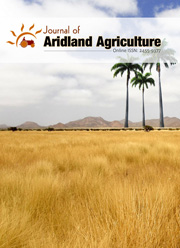Screening Triticum aestivum L. genotypes for drought stress tolerance under arid land conditions
DOI:
https://doi.org/10.19071/jaa.2015.v1.2934Abstract
Screening of drought tolerant genotypes for arid land cultivation is the best approach to avoid yield losses as breeding and selection are time taking techniques. Current experiment was planned to evaluate late sown wheat cultivars potential for drought tolerance and adaptability in Jeddah region, KSA. Four wheat cultivars (Yocoro, Rojo, Faisalabad-2008, F-10 and L-7096) were tested against drought stress applied as (75% and 50%) of total crop water requirement. A 100% water requirement was also applied as control. Data regarding crop growth stages, growth, grain yield and yield contributors were tested by using MSTAT-C. Drought stress significantly decreased all growth and yield traits except harvest index and the effect of water stress was the most severe where 50% of the total water requirement was applied. Both studied crop growth stages (days to complete tillering and days to complete 50% heading) were also affected to applied water stress and effect was more pronounced for days to complete 50% heading. Studied cultivars responded variably for different growth and yield traits. Cultivar Yoco Rojo took minimum days to complete tillering and heading while L-7096 presented the highest plant height and dry biomass accumulation. Faisalabad-2008 reported maximum values for grain yield and yield contributors except spike length that was maximum in Yocoro Rojo. Based on the field evaluation, it’s concluded that Faisalabad-2008 produced significant results for growth and yield traits among studied cultivars and can be successfully grown in arid land conditions under limited water supplies.Â
Downloads
References
Akram, M. (2011). Growth and yield components of wheat under water stress of different growth stages. Bangladesh Journal of Agricultural Research 36, 455-468.
Alghabari, F., Ihsan, M.Z., Hussain, S., Aishia, G., and Daur, I. (2015). Effect of Rht alleles on wheat grain yield and quality under high temperature and drought stress during booting and anthesis. Environmental Science and Pollution Research, 1-10.
Chaves, M., and Oliveira, M. (2004). Mechanisms underlying plant resilience to water deficits: prospects for water-saving agriculture. Journal of experimental botany 55, 2365-2384.
Chen, X., Min, D., Yasir, T.A., and Hu, Y.-G. (2012). Evaluation of 14 morphological, yield-related and physiological traits as indicators of drought tolerance in Chinese winter bread wheat revealed by analysis of the membership function value of drought tolerance (MFVD). Field Crops Research 137, 195-201.
Cushman, J.C., and Bohnert, H.J. (2000). Genomic approaches to plant stress tolerance. Current opinion in plant biology 3, 117-124.
DALIRIE, M.S., Sharifi, R.S., and Farzaneh, S. (2010). Evaluation of yield, dry matter accumulation and leaf area index in wheat genotypes as affected by terminal drought stress. Notulae Botanicae Horti Agrobotanici Cluj-Napoca 38, 182-186.
DenÄić, S., Kastori, R., Kobiljski, B., and Duggan, B. (2000). Evaluation of grain yield and its components in wheat cultivars and landraces under near optimal and drought conditions. Euphytica 113, 43-52.
Erdei, L., Tari, I., Csiszár, J., Pécsváradi, A., Horváth, F., Szabó, M., Ördög, M., Cseuz, L., Zhiponova, M., and Szilák, L. (2002). Osmotic stress responses of wheat species and cultivars differing in drought tolerance: some interesting genes (advices for gene hunting). Acta Biol Szeged 46, 63-65.
FAO. (2011). FAOSTAT (Food and Agriculture Organization of the United Nations: Rome, Italy). Available at http://faostat.fao.org/site/609/
Godfray, H.C.J., Beddington, J.R., Crute, I.R., Haddad, L., Lawrence, D., Muir, J.F., Pretty, J., Robinson, S., Thomas, S.M., and Toulmin, C. (2010). Food security: the challenge of feeding 9 billion people. science 327, 812-818.
Hossain, A., and DA SILVA, J.A.T. (2012). Phenology, growth and yield of three wheat (Triticum aestivum L.) varieties as affected by high temperature stress. Notulae Scientia Biologicae 4, 97-109.
Jaleel, C.A., Sankar, B., Murali, P., Gomathinayagam, M., Lakshmanan, G., and Panneerselvam, R. (2008). Water deficit stress effects on reactive oxygen metabolism in Catharanthus roseus; impacts on ajmalicine accumulation. Colloids and Surfaces B: Biointerfaces 62, 105-111.
Mattana, M., Biazzi, E., Consonni, R., Locatelli, F., Vannini, C., Provera, S., and Coraggio, I. (2005). Overexpression of Osmyb4 enhances compatible solute accumulation and increases stress tolerance of Arabidopsis thaliana. Physiologia Plantarum 125, 212-223.
Rajaram, S. (2001). Prospects and promise of wheat breeding in the 21st century. In Wheat in a global environment. (Springer), pp. 37-52.
Sanghera, A.K., and Thind, S. (2014). Screening of wheat genotypes at seedling stage for their potential to withstand heat stress on the basis of membrane thermosenstivity tests. International Journal of Agriculture and Crop Sciences 7, 640.
Seghatoleslami, M., Kafi, M., and Majidi, E. (2008). Effect of drought stress at different growth stages on yield and water use efficiency of five proso millet (Panicum miliaceum L.) genotypes. Pak. J. Bot 40, 1427-1432.
Vickers, C.E., Gershenzon, J., Lerdau, M.T., and Loreto, F. (2009). A unified mechanism of action for volatile isoprenoids in plant abiotic stress. Nature Chemical Biology 5, 283-291.





 .
.